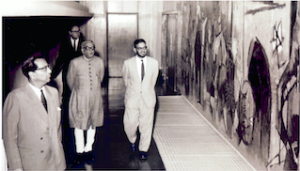Info
TIFR: Corporate and institutional art collections | Mumbai Mirror

 By Mortimer Chatterjee
By Mortimer Chatterjee
Published in Mumbai Mirror | 2 November, 2015
Any discussion of great institutional art collections whether in India or, indeed, globally, has to contend with the group of modern Indian paintings and sculptures housed at the Tata Institute of Fundamental Research (TIFR), based in South Mumbai.
It was the first director of the TIFR, Homi Bhabha, who initiated the idea of the collection in 1952, at about the same time that Nehru apportioned a large swathe of land for the building of a new campus for the Institute. From the outset, Bhabha was committed to housing his scientists in an environment that was highly sensitized to beauty, informed by an India newly emboldened through self-rule. The art took its place in a great modernist building set in elaborately landscaped gardens.
In order to build the TIFR holdings in the style of a great museum collection, the first director made the inspired decision to engage a group of advisors. These were all art world insiders, including the influential art critic Rudi Von Leyden. Add to this the fact that 1% of the yearly budget was apportioned to the acquisition of art, almost certainly a first in India.
The outcome of this meticulous planning was the creation of an art collection without peer. The collection is relatively small, less than three hundred paintings and sculptures, and yet the number of master works is remarkably high. It is worth remembering that Bhabha, and his advisors, were buying work from artists who, in the main, had no track record to speak of. Interesting new research released by the TIFR archives, headed by Oindrila Raychaudhuri, has shed light on how acquisitions were concentrated into a tight time period. Between 1961 and 1968 more than a dozen works were purchased per annum.
Highlights from the collection include a magnificent group of works by V.S. Gaitonde, that trace the artist’s career from the mid-1950s, right up till the 1970s. There are also large holdings of major names from the period, including K. H. Ara, Tyeb Mehta and M.F. Husain. Indeed, the Institute is custodian to one of the greatest of all Husain’s works, an awe-inspiring canvas that stretches the full length of a wall and greets visitors entering the main building of the campus. This work, executed during 1962 and 1963, came about as the result of a competition that invited young, mid-career and senior artists of the period submit to-scale proposals.
The mural competition included entrants such as Satish Gujral, N. S. Bendre and K. K. Hebbar who, at that time, were amongst the younger entrants. The most senior artist in the group was the great Bengali painter, Jamini Roy, and letters between him and Bhabha show that the Director of TIFR was keen to make it clear that any submission from Roy would be considered a finished work, and prized by the institute as such. This brilliant piece of diplomacy resulted in the old master from Calcutta making a work that must count as one of the largest single paintings ever executed by him. If making artists compete with each other was rare enough, Bhabha had even toyed with the idea of inviting the greatest living artist of that era, Pablo Picasso, to come to India and undertake the project. The plan came to nothing as the Sino Indian war had erupted in the meantime, causing difficulties with the logistics of foreign exchange.
Perhaps most exciting to the student of modern Indian art are the new insights that the TIFR art collection affords. In particular, the concentration of artists about whom little is written about today. An example of this is Homi Patel, an artist virtually absent from present scholarship, yet one who is strongly represented in the TIFR art collection.
Bhabha died prematurely in 1966, in an airplane crash in the Swiss Alps. This tragedy could well have seen interest in the art collection tapering off. Thankfully, the second director of the institute, M.G.K. Menon, was committed not only to maintain but, also, add significantly to the holdings.
After a lengthy period when the collection remained fairly remote from public consciousness, focus once more returned five years ago with a large-scale conservation program, the publication of a book on the collection and a major exhibition mounted at the National Gallery of Modern Art, Mumbai. Recently the TIFR became a new member of the Google Cultural Institute. With examples from the collection now also featuring in major international exhibitions, it is clear that the Institute is once again playing a full part in the global cultural discourse of our times. Bhabha would most certainly approve.
